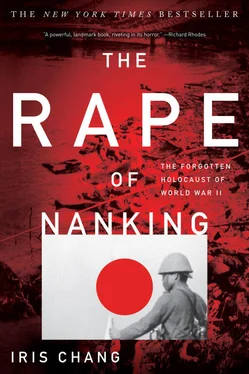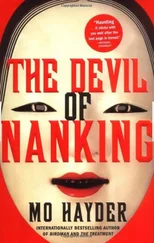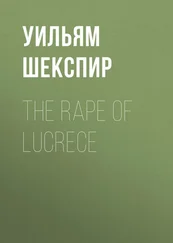162. People could be seen ransacking houses: Minnie Vautrin, diary 1937–40, February 10, 1938, p. 189.
162. On Shanghai Road in the Safety Zone: Ibid., January 9, 1938, p. 149; January 12, 1938, p. 153; January 27, 1938, p. 172.
162. This activity jump-started the local economy: Ibid., January 20, 1938, p. 163.
162. On January 1, 1938, the Japanese inaugurated: “A Short Overview Describing the Self-Management Committee in Nanking, 7 March 1938,” in “Deutsche Botschaft China,” German diplomatic reports, document starting on page 103, National History Archives, Republic of China; Minnie Vautrin diary 1937–40, December 30, 1937, and January 1, 1938; IMTFE Records, court exhibits, 1948, World War II War Crimes Records Collection, box 134, entry 14, record group 238, p. 1906, National Archives; Commanding Officer C. F. Jeffs to the Commander in Chief, U.S. Asiatic Fleet (letterhead marked the U.S.S. Oahu ), intelligence summary for the week ending April 10, 1938, April 11, 1938, Office of the Chief of Naval Operations, Division of Naval Intelligence, general correspondence, 1929–42, folder A8–21/FS#3, box 195, entry 81, record group 38, National Archives.
162. Running water, electric lighting: Commanding Officer C. F. Jeffs to the Commander in Chief, U.S. Asiatic Fleet (letterhead marked the U.S.S. Oahu ), intelligence summary for the week ending April 10, 1938, April 11, 1938, Office of the Chief of Naval Operations, Division of Naval Intelligence, general correspondence, 1929–42, folder A8–21/FS#3, box 195, entry 81, record group 38, National Archives.
162. Chinese merchants endured: Ibid.; “Deutsche Botschaft China,” document dated March 4, 1938, starting on page 107, German diplomatic reports, National History Archives, Republic of China; “A Short Overview Describing the Self-Management Committee in Nanking, 7 March 1938,” in “Deutsche Botschaft China,” document no. 103.
162. The Japanese also opened up military shops: “Deutsche Botschaft China,” document dated May 5, 1938, starting on page 100, German diplomatic reports, National History Archives, Republic of China.
162. The Chinese puppet government compounded the poverty: “A short Overview Describing the Self-Management Committee in Nanking, 7 March 1938,” in ibid., document starting on page 103.
163. “We are now doing an authorized plundering”: Ibid.
163. Far more alarming than the exploitation of the populace: For information on the drug trade, see Bates, testimony before the IMTFE, pp. 2649–54, 2658.
163. Some even tried to use opium to commit suicide: Elizabeth Curtis Wright, My Memoirs (Bridgeport, Conn.: Winthrop Corp., 1973), box 222, Yale Divinity School Library.
163. Others turned to crime: “Deutsche Botschaft China,” document dated March 4, 1938, starting on page 107, German diplomatic reports, National History Archives, Republic of China.
163. Japanese employers treated many of the local Chinese laborers: Tang Shunsan, interview with the author, Nanking, People’s Republic of China, July 26, 1995.
164. The Japanese even inflicted medical experiments: Sheldon Harris, Factories of Death: Japanese Biological Warfare, 1932–1945, and the American Cover-up (London: Routledge, 1994), pp. 102–12.
165. The Japanese authorities devised a method of mass control: “From California to Szechuan, 1938,” Albert Steward diary, entry for December 20, 1939, private collection of Leland R. Steward.
165. The dreaded famine never struck: Lewis Smythe, “War Damage in the Nanking Area,” pp. 20–24; Minnie Vautrin, diary 1937–40, May 5, 1938.
166. The gardens and farms inside the city walls: Minnie Vautrin, diary 1937–40, May 21, 1938; “Notes on the Present Situation, March 21, 1938,” p. 1, Fitch Collection, Yale Divinity School Library.
166. But there is no evidence to suggest: Mark Eykholt, telephone interview with the author.
166. They also began an aggressive inoculation program: Ibid. While the Japanese used deadly biological warfare against other cities, it is clear that they took precautions to protect Japanese-occupied territories like Nanking from epidemics, probably because of the presence of Japanese nationals in those areas.
166. Children of Western missionaries also remember: Angie Mills, telephone interview with the author.
166. sprayed with Lysol: letter dated February 12, 1939, by unidentified author, Forster Collection, RG 8, Box 263, Yale Divinity School Library.
166. In the spring of 1938, men started to venture back to the city: Eykholt interview.
167. Occasionally there was underground resistance: Ibid.
167. The Japanese remained in the former capital: Author’s interviews with survivors.
169. In March 1944, the United Nations: “Judgment of the Chinese War Crimes Military Tribunal on Hisao Tani, March 10, 1947,” Journal of Studies of Japanese Aggression Against China (February 1991): 68.
170. During the trials: Xu Zhigeng, The Rape of Nanking, pp. 219, 223, 226, 228.
170. One of the most famous exhibits: Television documentary on Wu Xuan and Luo Jing, aired July 25, 1995, Jiangsu television station channel 1.
171. A Japan Advertiser article: Xu Zhigeng, The Rape of Nanking, pp. 215–16.
171. The focal point of the Nanking war crimes trials: Ibid., pp. 218–30.
172. The scope of the trial was staggering: For statistics on the IMTFE, see Arnold Brackman, The Other Nuremberg: The Untold Story of the Tokyo War Crimes Trials (New York: Morrow, 1987), pp. 9, 18, 22; World War II magazine, January 1996, p. 6.
173. “At the IMTFE, a thousand My Lais emerged”: Ibid., p. 9.
173. The prosecution learned: IMTFE transcript.
173. Only one in twenty-five American POWs died: Ken Ringle, “Still Waiting for an Apology: Historian Gavan Daws Calling Japan on War Crimes,” Washington Post , March 16, 1995; author’s telephone interview and electronic mail communication with Gavan Daws. According to Daws, the death-rate figure for all Allied POWs for the Japanese was 27 percent: 34 percent for Americans, 33 percent for Australians, 32 percent for the British, and under 20 percent for the Dutch. In contrast, the death rate for all Western Front Allied military POWs of the Germans (excluding Russians) was 4 percent. For more information, see Gavan Daws, Prisoners of the Japanese: POWs of World War II in the Pacific (New York: Morrow, 1994), pp. 360–61, 437.
173. “The Rape of Nanking was not the kind of isolated incident”: Brackman, The Other Nuremberg, p. 182.
174. “let loose like a barbarian horde”: IMTFE judgment.
174. “chastise the Nanking government”: IMTFE judgment.
174. To atone for the sins of Nanking: Bergamini, Japan’s Imperial Conspiracy, pp. 3–4.
175. “I am happy to end this way”: Ibid., p. 47.
175. “either secretly ordered or willfully committed”: IMTFE judgment, p. 1001.
175. Unfortunately, many of the chief culprits: Buruma, The Wages of Guilt, p. 175; Bergamini, Japan’s Imperial Conspiracy, pp. 45–48.
175. The information about Nakajima Kesago comes from Kimura Kuninori, Koseiha shogun Nakajima Kesago [ Nakajima Kesago, General of the Individualist Faction ]. Tokyo: Kôjinsha, 1987.
Читать дальше











